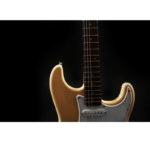There are so many notes on the guitar — and just as many ways to get lost among them. Six strings, twenty-two frets, infinite possibilities. Some players chase scales like a checklist, but a better way exists: mapping your fretboard through B minor guitar scales.
The B minor scale isn’t just another pattern to memorize; it’s a gateway to understanding how intervals, chords, and melodies live on the neck. Once you can “see” where every B, D, and F# connects, you stop feeling lost. Suddenly, your solos breathe. Your chord shapes make sense. The neck becomes one instrument instead of six strings stitched together.
In this post, we’ll explore how to use B minor guitar scales to map your fretboard, one interval and one connection at a time — and how to turn that understanding into music that sounds intentional.
🎸 The Beauty (and Challenge) of the Fretboard
Let’s start with an honest truth: the guitar is not laid out logically. Notes repeat, patterns overlap, and the tuning of the B string throws off symmetry just enough to confuse you.
But this chaos is also what makes it beautiful.
Every string holds a story — and when you learn to read those stories through B minor guitar scales, you begin to hear relationships rather than shapes.
That’s the essence of fretboard mastery: not memorizing patterns but understanding connections.
Think of your fretboard like a map. Every note in B minor (B, C#, D, E, F#, G, A) appears multiple times across your neck, waiting to be discovered.
Your job isn’t to play faster — it’s to navigate smarter.

🎸 Join the Guitar Freaks Patreon!
Get SoloCraft™ E-Book & FretDeck™ FREE!
Join Guitar Freaks on Patreon and instantly unlock my full e-book SoloCraft & FretDeck™ Guitar Scales—your step-by-step guide to fretboard mastery and crafting soulful solos.
New video lesson drops every Friday so you’ve always got a fresh, focused practice plan for the week.
👉 Don’t miss out—join now and grab your free copy!
🧭 Step One: Use the Circle of 4ths
The circle of 4ths is one of the most powerful tools for mapping the guitar. You’ve probably seen it — C, F, B♭, E♭, and so on — looping through every key.
But instead of treating it like theory trivia, use it like a fretboard compass.
Here’s how:
- Start with a single string.
- Play each note of the circle of 4ths aloud — C, F, B♭, E♭, A♭, etc.
- Say the note name as you play it.
- Move through the entire circle, slowly and deliberately.
This simple act of speaking and playing connects your cerebellum (movement) and cerebrum (memory). You’re not just memorizing notes — you’re training your brain to see music spatially.
Once you’re comfortable, try the same idea in B minor guitar scales.
Start on the 7th fret of the low E (that’s your B). Play the B minor scale up and down, saying each note aloud. Then move one string higher and repeat.
It feels mechanical at first, but within a few days, you’ll start seeing the fretboard differently.
🧩 Step Two: Map Intervals Through B Minor Guitar Scales
An interval is the distance between two notes.
When you map intervals, you start hearing how the fretboard connects — and that’s the foundation of musical phrasing.
Let’s use your root note, B (7th fret on the low E string), and explore intervals ascending through the B minor guitar scale:
- Minor 2nd: same string, one fret up
- Major 2nd: same string, two frets up
- Minor 3rd: same string, three frets up
- Major 3rd: one string over, one fret back
- Perfect 4th: one string over, same fret
- Perfect 5th: one string over, two frets up
- Minor 6th: one string over, three frets up
- Major 6th: two strings over, one fret back
- Minor 7th: two strings over, same fret
- Octave: two strings over, two frets up
When you physically play these, you’ll notice something — they don’t look symmetrical across all strings. That’s because of the tuning difference between the G and B strings (a major 3rd instead of a perfect 4th).
To adjust, remember:
“Any interval that crosses the B string needs to shift one fret higher.”
Once you internalize that rule, your fretboard mapping becomes second nature.
🎶 Step Three: Practice with Awareness (Not Just Speed)
Guitarists love speed. But mapping your fretboard isn’t about how fast you move — it’s about how aware you become.
Try this:
- Set your metronome to a slow tempo.
- Let four “ticks” go by between each note.
- Close your eyes and visualize where the next note in the B minor guitar scale is.
- Play it, name it, and listen to how it relates to the previous one.
This might sound simple, but it’s one of the most transformative exercises you can do.
You’re not just building finger strength — you’re rewiring your brain to understand the instrument on a deeper level.
Over a few days, reduce the space between metronome clicks: three beats, two, one. You’ll start gliding across the fretboard effortlessly — not because of muscle memory, but because of mental mapping.
🎼 Step Four: Connect Scales to Chords
Once you can visualize your B minor guitar scales across all strings, it’s time to connect that knowledge to chords.
This is where theory turns into music.
Start with a simple open F chord shape, but think in terms of B minor.
You can move this shape across the circle of 4ths, maintaining the same chord form while tracking your root note.
Let’s say you’re playing an F-shape barre chord rooted on the 4th string. That root note defines everything.
If you move that root up a fourth — to E, then A, then D — the chord form stays consistent, but the harmonic function evolves.
You’re no longer just shifting shapes — you’re understanding movement.
Now bring your B minor scale back into play.
Each of those chord roots exists within your scale, meaning your lead lines can weave naturally around the harmony. This is where great phrasing is born — connecting scale tone to chord tone.
🧠 Step Five: Visualize the Fretboard as a Mental Map
The best players don’t stare at their guitars. They see the neck in their minds.
Close your eyes and picture the B minor scale across the fretboard. See the root notes, the octaves, the repeating 3rds and 5ths.
The more vividly you can imagine them, the faster your hands will find them in real life.
Adam Levy once said something that stuck with me:
“If you can see the neck in your head, you’ll never be lost again.”
Visualization isn’t just a mental trick — it’s how you bridge the gap between practice and performance.
When you can mentally trace the shape of a B minor guitar scale without looking, your playing becomes freer, more musical, and infinitely more expressive.

🎸 Join the Guitar Freaks Patreon!
Get SoloCraft™ E-Book & FretDeck™ FREE!
Join Guitar Freaks on Patreon and instantly unlock my full e-book SoloCraft & FretDeck™ Guitar Scales—your step-by-step guide to fretboard mastery and crafting soulful solos.
New video lesson drops every Friday so you’ve always got a fresh, focused practice plan for the week.
👉 Don’t miss out—join now and grab your free copy!
🪶 The “Circle Practice” Method
Here’s a weekly routine inspired by both Adam Levy and jazz educators like Mick Goodrick:
- Choose one key — B minor.
- Play it across every string, naming notes aloud.
- Move through the circle of 4ths every day.
- Don’t rush. Just feel the distance between notes.
- Add chord shapes that connect naturally within that key.
If you stick with this for a week, you’ll know every B, D, and F# on the neck.
If you stick with it for a month, you’ll start hearing new connections in every song you play.
🎯 The Goal: From Scales to Freedom
When you first learn B minor guitar scales, it’s easy to get caught up in finger placement.
But the real magic happens when you can stop thinking about where to go — and just play.
Mapping the fretboard isn’t about memorization; it’s about liberation.
When you know how notes connect, your solos sound intentional. Your chords flow. You stop chasing YouTube licks and start writing your own.
It’s like switching from reading a script to speaking your own language.
💡 Pro Tip: The B String Rule
That infamous B string throws everyone off. Here’s the trick again, because it’s that important:
Any shape that crosses the B string — whether it’s a scale, triad, or interval — must move one fret higher.
Memorize that, and suddenly all your scale shapes and chord grips make sense.
You’ll stop hitting sour notes and start connecting patterns with confidence.
That’s fretboard fluency.
🎵 Bonus: The B Minor Improv Map
Once you’re comfortable with the B minor guitar scale, here’s how to turn it into creative fuel.
Try this 10-minute improvisation workout:
- Play one position of the B minor scale.
- Add intervals — 3rds, 5ths, and 6ths — for melody depth.
- Shift your starting root around the circle of 4ths (B → E → A → D, etc.).
- Create one short melodic phrase in each position before moving on.
Do this every morning for a week.
You’ll start to hear the personality of B minor — its melancholy pull, its tension, and its lyrical sweetness.
💬 Reflection: What This Really Teaches You
The goal isn’t to master one scale; it’s to master connection.
When you work through B minor guitar scales this way, you’re teaching your brain how to find relationships — not just notes.
Every solo you love — from David Gilmour to Robben Ford — is built on that same foundation: knowing where the next note lives before you play it.
You can’t fake that kind of confidence.
You can only build it — one mapped note at a time.
🚀 Join the Guitar Freaks Patreon (Dan Kennedy–Style CTA)
Let’s be real. Reading about this is one thing — but the real growth happens when you do the work.
Inside my Guitar Freaks Patreon, I’ve created printable B minor scale maps, weekly fretboard drills, and guided practice prompts that make this process effortless.
You’ll get:
- 52 guitar challenges built around real fretboard fluency
- Backing tracks to solo over in B minor
- Exclusive tutorials that never make it to YouTube
If you’re serious about mastering your fretboard — and you want a community of players who practice with purpose — then you belong inside.
👉 Join today at Patreon.com/GuitarFreaks and start your next 7-day B minor mastery challenge.

🎸 Join the Guitar Freaks Patreon!
Get SoloCraft™ E-Book & FretDeck™ FREE!
Join Guitar Freaks on Patreon and instantly unlock my full e-book SoloCraft & FretDeck™ Guitar Scales—your step-by-step guide to fretboard mastery and crafting soulful solos.
New video lesson drops every Friday so you’ve always got a fresh, focused practice plan for the week.
👉 Don’t miss out—join now and grab your free copy!
✅ Key Takeaways
- Map your fretboard using B minor guitar scales as your guide.
- Practice the circle of 4ths to move between keys seamlessly.
- Speak every note as you play it — it locks theory into muscle memory.
- Adjust one fret higher whenever you cross the B string.
- Connect scales to chords and intervals for total freedom.
Internal Link:
How to Master the Five Pentatonic Patterns on Guitar
Outbound Link:
Online Music Theory Course for Guitar – Hub Guitar — Free online lessons geared toward guitar players, including topics like intervals, scale formulas, and how the fretboard is tuned










